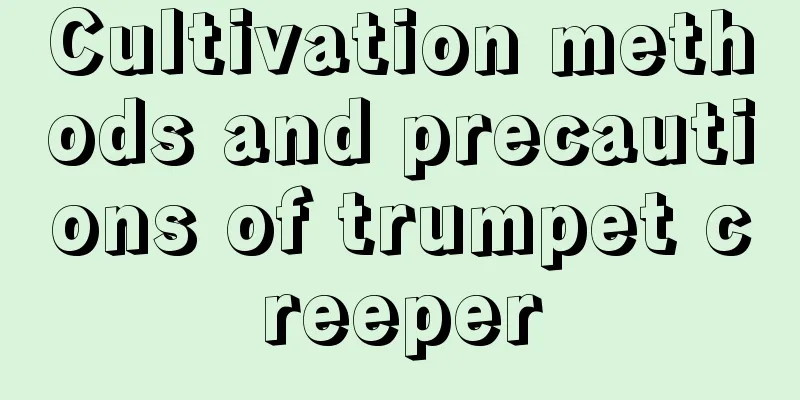Cultivation methods and precautions of trumpet creeper

How to grow trumpet creeperPot soil selectionWhen planting potted trumpet creepers, choose deep, airtight clay pots or wooden barrels. Fill the pot with fertile, loose, well-drained, neutral or slightly acidic soil. Alternatively, you can mix leaf mold with garden soil. Soil dug from the street can also be used after being exposed to the sun and adding some base fertilizer. (The best is fertile pine needle soil) Placement EnvironmentTrumpet creeper likes an environment with plenty of sunlight. In a semi-shady environment, the plant will not grow vigorously and the flowers will be few and light in color. Place the plant in a sunny courtyard, balcony, south- or west-facing balcony if possible, and make sure to ventilate it in time. Do not place the flower pots in north-facing or enclosed balconies. Water and fertilizer requirementsTrumpet creeper likes a humid environment, is slightly drought-resistant, and is afraid of waterlogging. Therefore, water the plant frequently during the growing season to keep the soil in the pot slightly moist but not waterlogged. Trumpet creeper will enter a dormant period from late autumn to the following spring. At this time, the soil in the pot should be kept dry and slightly moist. Trumpet creeper is very fond of fertilizer. In addition to adding sufficient base fertilizer to the soil when potting and repotting, nitrogen-based fertilizer should be applied once every 10 to 15 days after germination to promote the growth of branches and leaves. But starting from May , fertilizers mainly composed of phosphorus and potassium should be applied to promote flower bud differentiation and bud formation. Starting from June , spray 0.2% potassium dihydrogen phosphate solution on the leaves once every 7 to 10 days to promote bright blooming. Apply phosphorus and potassium fertilizers 1 to 2 times after the flowers fade to ensure sufficient nutrients before wintering. Trumpet creeper hibernates in winter, so do not fertilize it. Proper trimmingAfter a short dormancy in winter, the plants will enter a vigorous growth period in early spring, so it is necessary to promptly cut off dead branches, weak branches, overgrown branches, and messy branches in early spring, and shorten the overly long branches to promote the sprouting of new strong branches. Precautions for the cultivation of trumpet creeperPest controlThe water and fertilizer requirements for trumpet creeper mention that trumpet creeper likes a humid environment, but also in a high temperature and high humidity environment. Trumpet creeper is easily harmed by aphids. Therefore, it is required to ventilate frequently during the maintenance process to ensure sufficient humidity, but appropriate cooling is required to avoid insect pests. In addition, once aphids are found, rinse them with clean water or spray them with pesticides in time to avoid serious insect infestation. Setting up the support poleTrumpet creeper is a climbing plant. When it grows to a certain extent, it needs to set up supporting poles and build a frame for it to climb and grow. At home, you can place the trumpet creeper at the bottom of the flower stand and let it climb the edge of the flower stand to grow. It can decorate the flower stand and save the trouble of setting up a bracket. Pruning skillsUsually when buds sprout in early spring each year, for plants over 5 years old, the main trunk is shortened to 30~40 cm, and the roots are pruned at the same time to retain the main root system and replant. After new branches sprout out from the pot, only keep 3 to 5 new branches on the top and cut off the rest. Control the water and fertilizer. After a year of maintenance, you will have a beautiful and young trumpet creeper again. |
<<: Classification of lucky tree species
>>: How to grow magnolia at home
Recommend
How to grow Christmas cactus to make it bloom
Flowering time of Christmas cactus The flowering ...
How to grow Christmas cactus
1. Breeding environment 1. Light: Because the pla...
Cultivation methods and precautions of Queen's Flower Hat
1. Maintenance methods 1. Soil: The Queen's F...
Is orchid a bluegrass? What is the difference?
1. Are they the same? Orchids are not orchid gras...
Disease and Pest Control of Sugar Apple
anthrax If the sugar apple is infected with anthr...
Is the red Bianhua poisonous? Is the red Bianhua precious?
1. Is it poisonous? Red spider lily is poisonous....
The language and legend of Wisteria
The language of wisteria flowers Wisteria flowers...
How to water the cactus
Key points for watering cactus Cactus prefers a w...
Why don't you grow bamboo cypress at home?
1. Why don’t you grow bamboo cypress at home? Bam...
Don’t buy these 4 kinds of flowers no matter how big a discount they are, as you will be poisoned if you come into contact with their “juice”!
We all know that there were many "femme fata...
How to grow loofah to get high yield? Do I need to top it off?
Luffa is a common vegetable with high nutritional...
What are the scented teas for OL beauty and health care?
Beauty tea Rose has the effect of nourishing the ...
How to propagate peony
Propagation by division It can be propagated by d...
How to propagate violets
1. Method Seed propagation 2. Time Available from...
Why does the goldfish plant lose its leaves and how to remedy it
1. Reasons for leaf drop 1. The light is too stro...









